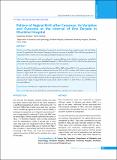Please use this identifier to cite or link to this item:
https://hdl.handle.net/20.500.14356/1276| Title: | Pattern of Vaginal Birth after Cesarean, its Variables and Outcome at the Interval of One Decade in Dhulikhel Hospital |
| Authors: | Tamrakar, Suman Raj Timilsina, Neeta |
| Citation: | TamrakarS. R., & TimilsinaN. (2020). Pattern of Vaginal Birth after Cesarean, its Variables and Outcome at the Interval of One Decade in Dhulikhel Hospital. Journal of Nepal Health Research Council, 18(3), 411-415. https://doi.org/10.33314/jnhrc.v18i3.2626 |
| Issue Date: | 2020 |
| Publisher: | Nepal Health Research Council |
| Article Type: | Original Article |
| Keywords: | Cesarean section Fetal distress Institutional delivery Obstetric care Uterine rupture |
| Series/Report no.: | Jul-Sep 2020; |
| Abstract: | Abstract Background: There should be high index of suspicion for timely detection of any complications for safe trial of labor in case of vaginal birth after cesarean. Emergency obstetric care must be available. Even with these provisions the vaginal birth after cesarean rate is decreasing in Dhulikhel Hospital in recent years. Methods: This retrospective study was conducted to compare different modes of delivery and pattern vaginal birth after cesarean in a gap of ten years in Dhulikhel Hospital (i.e. 2007 to 2009 versus 2017 to 2019). In this study factors associated with the successful vaginal birth after cesarean were also analyzed. Results: A total of 4215 deliveries conducted in the year 2007 to 2009, of them 890 (21.1%) were cesarean deliveries. Likewise altogether 9298 deliveries conducted in the year 2017 to 2019, of them 2849 (30.6%) were cesarean deliveries. Vaginal birth after cesarean rate is significantly decreased from 18.33% (33/180) to 8.8% (63/713) (p value = 0.0004). Instrumental deliveries, normal vaginal deliveries were significantly decreased in comparison to these in the year 2007 to 2009. Duration of labor of vaginal birth after cesarean (7.05±1.25 vs 7.13±2.02, p=0.8362) and mean fetal weight of vaginal birth after cesarean baby (2818.71±686.37 vs 2820.79±511.78, p=0.9867) were not much different. Conclusions: Over the years, vaginal birth after cesarean rate is decreased. Keywords: Cesarean section; fetal distress; institutional delivery; obstetric care; uterine rupture |
| Description: | Original Article |
| URI: | http://103.69.126.140:8080/handle/20.500.14356/1276 |
| ISSN: | Print ISSN: 1727-5482; Online ISSN: 1999-6217 |
| Appears in Collections: | Vol. 18 No. 3 (2020): Vol. 18 No. 3 Issue 48 Jul-Sep 2020 |
Files in This Item:
| File | Description | Size | Format | |
|---|---|---|---|---|
| 2626-Manuscript-18833-1-10-20201115.pdf | 326.96 kB | Adobe PDF |  View/Open |
Items in DSpace are protected by copyright, with all rights reserved, unless otherwise indicated.
